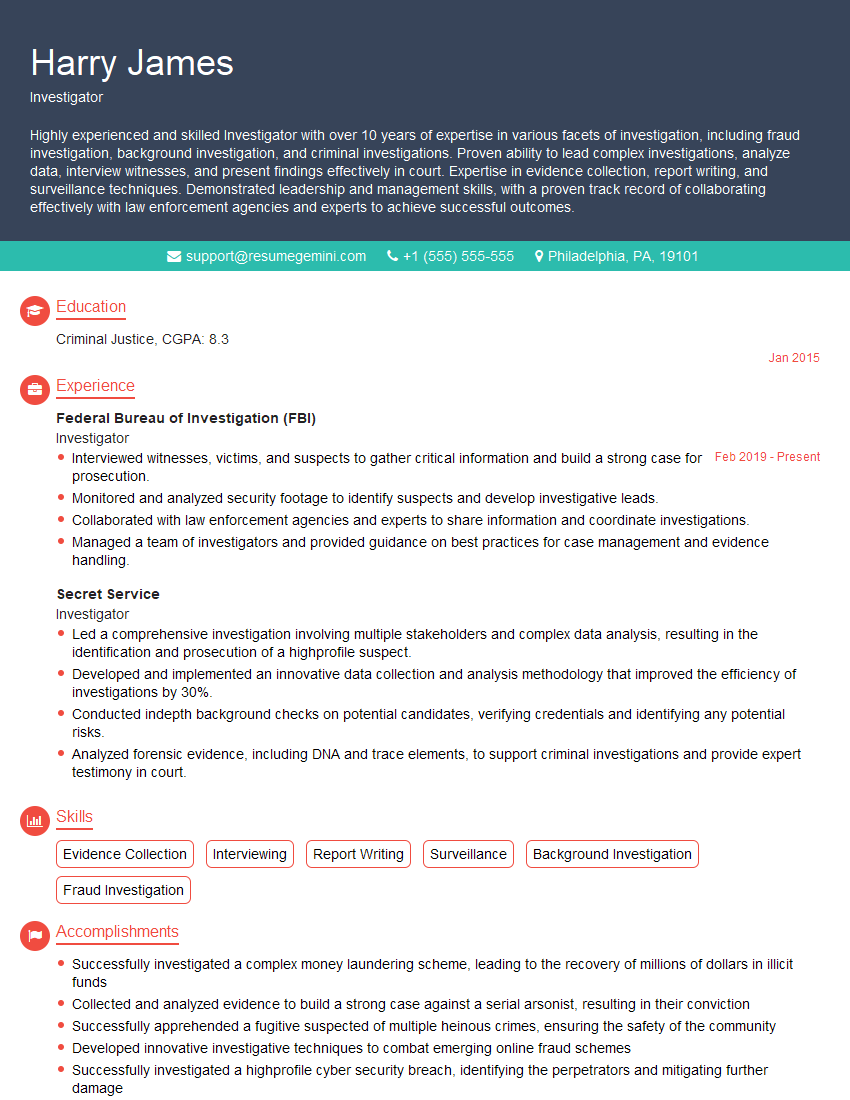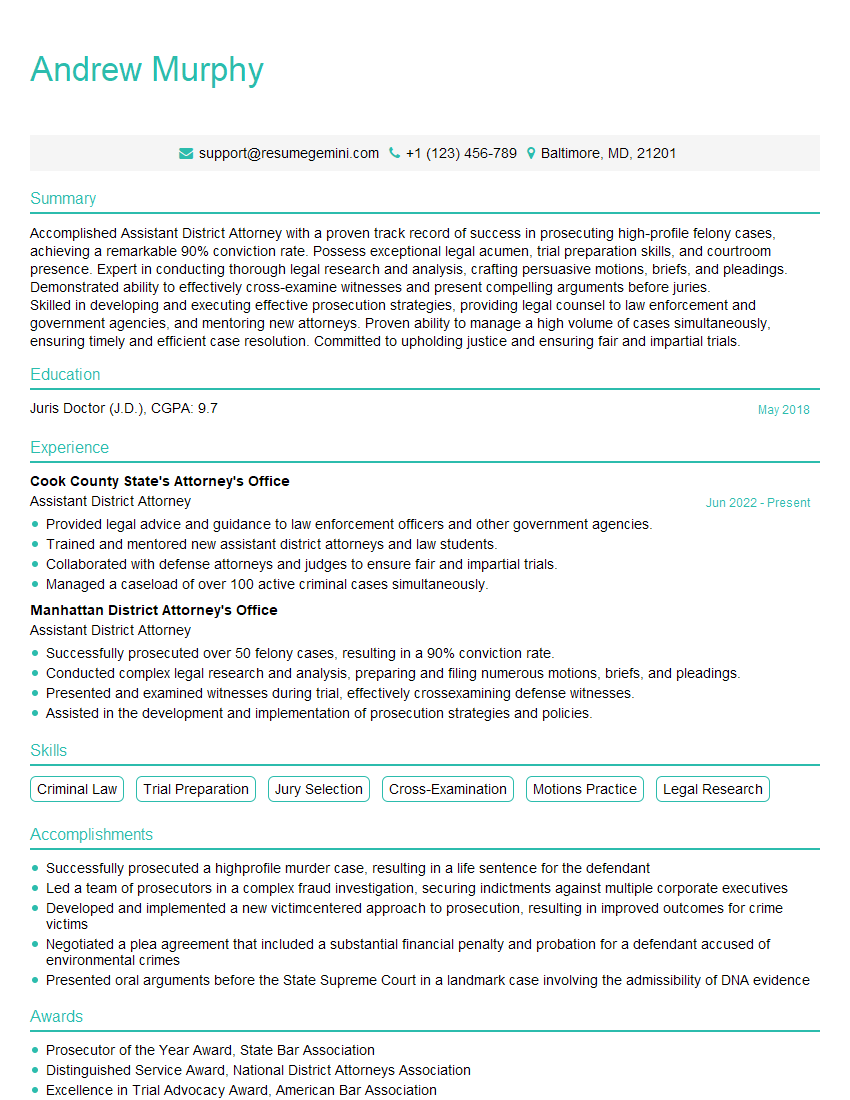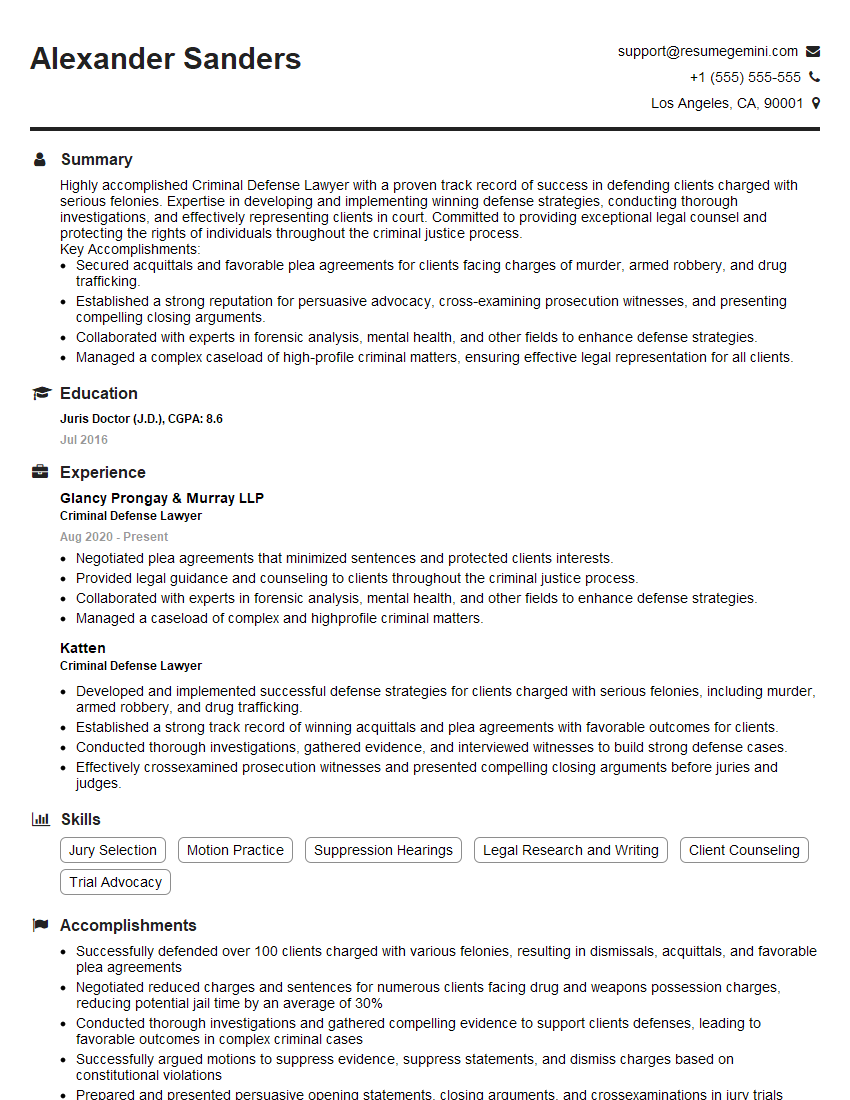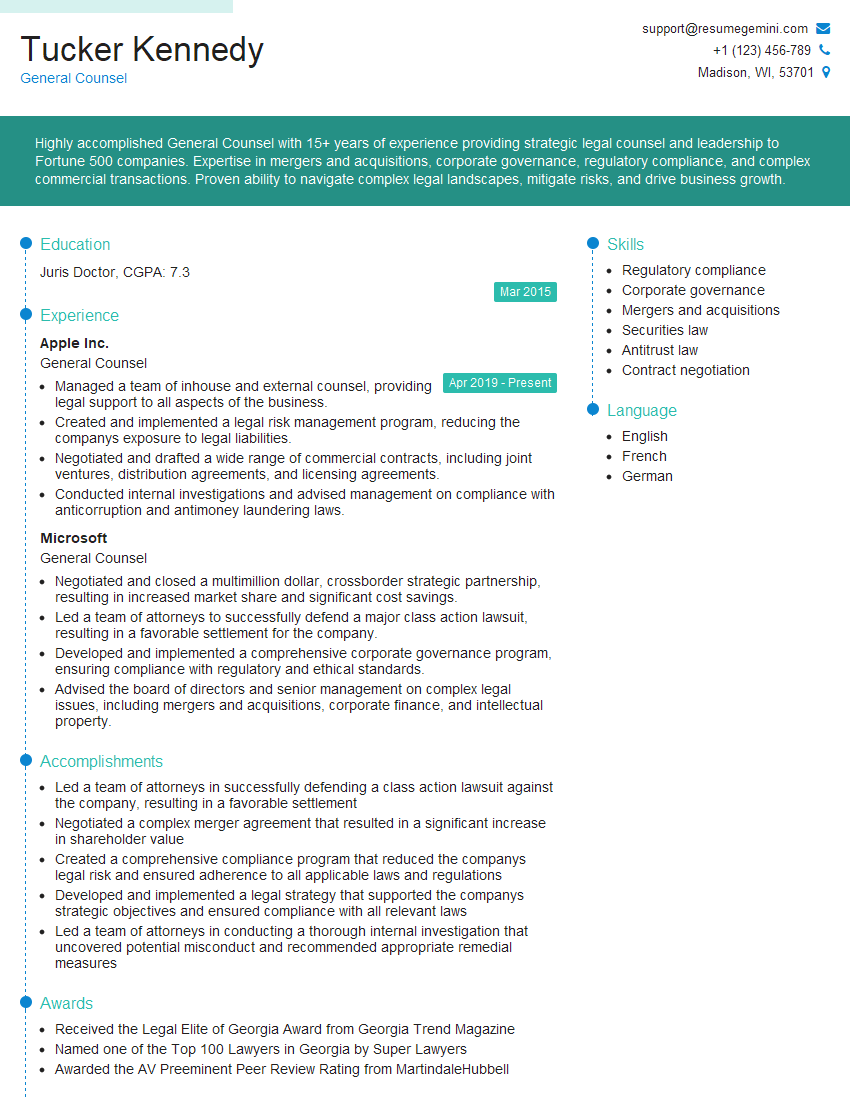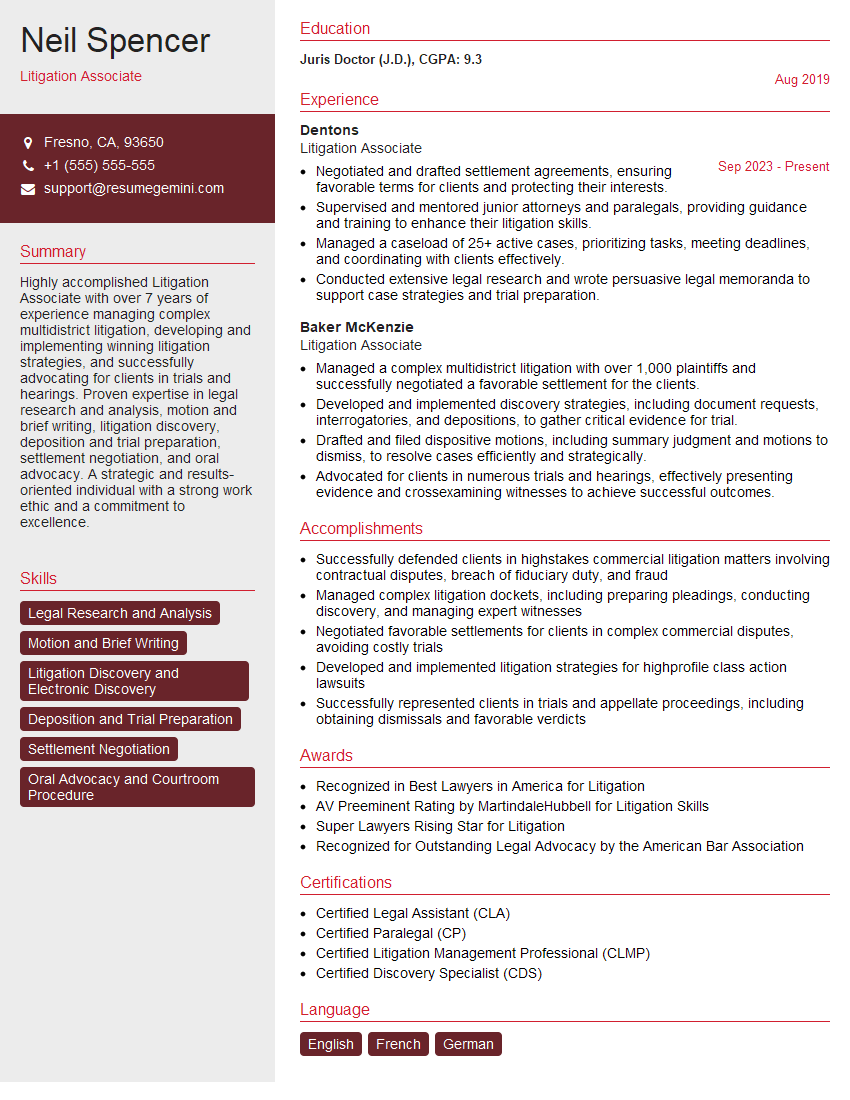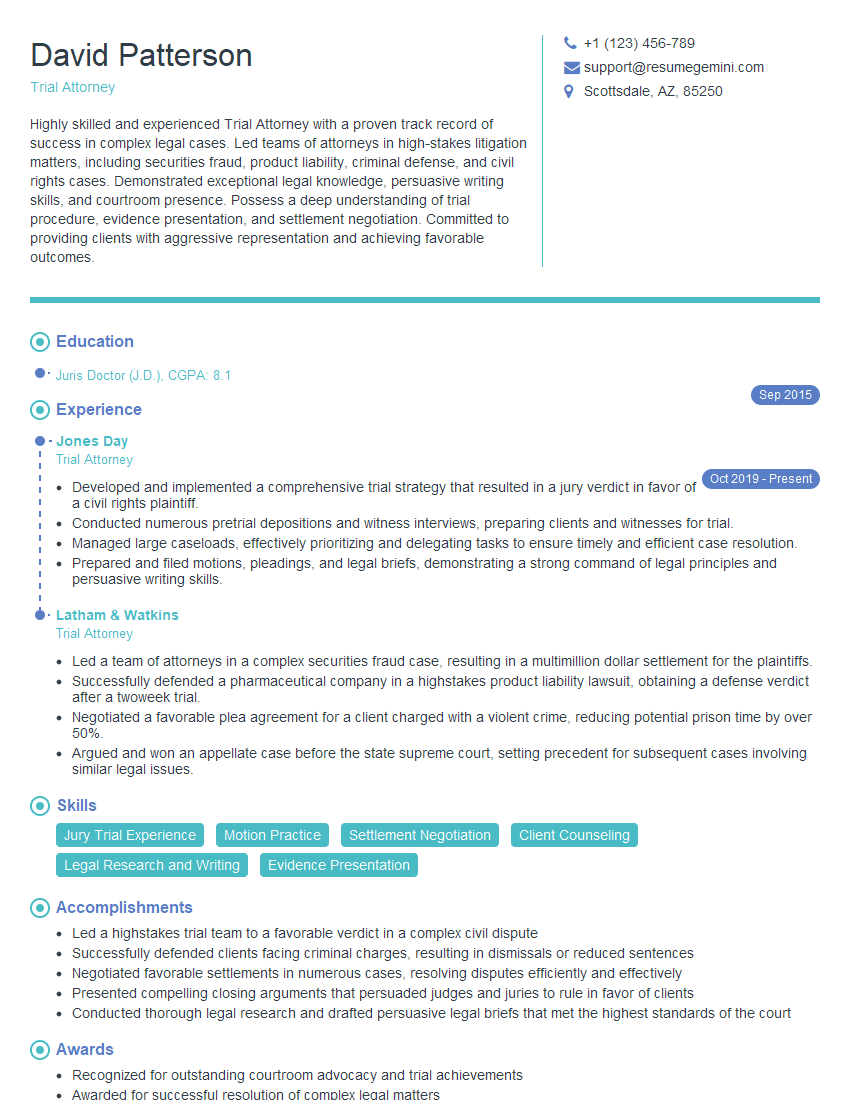The thought of an interview can be nerve-wracking, but the right preparation can make all the difference. Explore this comprehensive guide to Criminal Litigation interview questions and gain the confidence you need to showcase your abilities and secure the role.
Questions Asked in Criminal Litigation Interview
Q 1. Explain the difference between direct and circumstantial evidence.
The core difference between direct and circumstantial evidence lies in their relationship to the fact in question. Direct evidence directly proves a fact, without requiring any inference. Think of it as eyewitness testimony: someone saw the defendant commit the crime. Circumstantial evidence, on the other hand, requires inference. It doesn’t directly prove the fact but suggests it through a chain of events or circumstances. For example, finding the defendant’s fingerprints at the crime scene is circumstantial; it suggests involvement but doesn’t definitively prove guilt.
Example of Direct Evidence: A witness testifies, “I saw the defendant stab the victim.”
Example of Circumstantial Evidence: The defendant’s fingerprints are found on the murder weapon, and the defendant was seen arguing with the victim earlier that day. This evidence, while highly suggestive, doesn’t directly prove the defendant committed the murder. A jury must infer guilt from the accumulation of circumstantial evidence.
Q 2. Describe the process of jury selection.
Jury selection, also known as voir dire, is a crucial stage where both the prosecution and the defense attempt to assemble a fair and impartial jury. It begins with a pool of potential jurors, summoned from the community. Attorneys then question these potential jurors, aiming to uncover biases, prejudices, or any other factor that might impair their ability to judge the case objectively. This questioning can involve asking about personal experiences, beliefs, and knowledge of the case.
The process involves several steps:
- Questioning Potential Jurors: Attorneys ask questions designed to reveal potential biases. They might inquire about prior experiences with the law, relationships with law enforcement, or strong opinions on relevant issues.
- Challenges for Cause: If an attorney believes a juror is demonstrably biased or unfit to serve, they can challenge that juror “for cause.” If the judge agrees, the juror is dismissed.
- Peremptory Challenges: Each side typically has a limited number of peremptory challenges, allowing them to dismiss potential jurors without stating a specific reason. However, these challenges cannot be used to discriminate based on race or gender.
- Jury Selection Completion: Once both sides are satisfied with the chosen jurors, the jury is sworn in and the trial begins.
The goal is not to select a jury that agrees with your side, but rather one that is capable of fairly considering the evidence and applying the law as instructed by the judge. A skilled attorney carefully crafts questions and utilizes challenges to shape a jury that is receptive to their case’s arguments.
Q 3. What are the key elements of a successful criminal defense strategy?
A successful criminal defense strategy hinges on several key elements. It’s not simply about proving innocence; it’s about meticulously challenging the prosecution’s case and presenting the best possible defense for the client. Key elements include:
- Thorough Investigation: Gathering all available evidence, interviewing witnesses, and exploring every possible defense theory are crucial. This often involves painstaking work, reviewing police reports, forensic evidence, and other relevant documents.
- Effective Communication: This includes communicating clearly with the client, the judge, the jury, and the opposing counsel. Articulating the client’s story persuasively is vital.
- Strategic Plea Bargaining: In many cases, a plea bargain can be a viable option to avoid the risks and uncertainties of a trial. A skilled attorney can negotiate the best possible outcome for their client.
- Aggressive Cross-Examination: A strong cross-examination can expose weaknesses in the prosecution’s case and discredit their witnesses.
- Strong Closing Argument: A compelling closing argument can leave a lasting impression on the jury, effectively summarizing the defense’s position and highlighting its strengths.
- Understanding the Law: A deep knowledge of the applicable laws, rules of evidence, and court procedures is paramount.
A successful defense strategy is often a delicate balance of these elements, tailored specifically to the facts of each case. There’s no one-size-fits-all approach.
Q 4. Explain the concept of ‘beyond a reasonable doubt’.
“Beyond a reasonable doubt” is the standard of proof required to convict a defendant in a criminal trial. It doesn’t mean absolute certainty; there is no such thing in criminal justice. Instead, it means that the evidence must be so compelling that there are no significant doubts remaining about the defendant’s guilt. Think of it this way: if, after considering all the evidence, a reasonable person would still harbor significant doubts about the defendant’s guilt, then the prosecution has not met its burden of proof.
It’s a high standard designed to protect the innocent. The prosecution must present sufficient evidence to eliminate any reasonable doubt in the minds of the jurors. If even a single juror maintains a reasonable doubt, the defendant must be acquitted.
The concept is often explained through analogies. Imagine a scale of justice. The prosecution’s evidence must heavily outweigh any reasonable doubt to tip the scale decisively toward guilt.
Q 5. How would you handle a conflict of interest in a criminal case?
A conflict of interest arises when a lawyer’s representation of a client is compromised by their personal interests or their obligations to another client. In a criminal case, this is a serious ethical violation. If I detected a conflict of interest, my immediate response would follow these steps:
- Identify the Conflict: Carefully analyze the situation to precisely define the nature and extent of the conflict.
- Inform the Client: I am obligated to immediately inform my current client about the conflict and its potential implications on their case.
- Seek Ethical Guidance: Consult with my supervising attorney, ethics committees, or relevant legal authorities for guidance.
- Withdrawal from Representation: If the conflict cannot be resolved in a way that protects my client’s interests, I would have to withdraw from representing the client.
- Referral to Other Counsel: If appropriate, I would refer my client to another attorney who can represent them without a conflict of interest.
Preventing conflicts of interest is paramount. This begins with careful screening of potential clients and regularly assessing for potential conflicts throughout the course of representation.
Q 6. Discuss the importance of preserving the chain of custody for evidence.
Preserving the chain of custody for evidence is crucial to ensuring its admissibility in court. The chain of custody documents the chronological history of who handled the evidence, when, and under what conditions. Any break in this chain can cast doubt on the evidence’s integrity and potentially lead to its exclusion from the trial. It demonstrates that the evidence presented in court is the same evidence collected at the scene and hasn’t been tampered with.
Maintaining the chain of custody involves meticulous record-keeping. This includes:
- Detailed Documentation: Every person who handles the evidence must be meticulously documented, along with the date, time, and location of each transfer.
- Secure Storage: The evidence must be securely stored to prevent contamination, loss, or alteration.
- Proper Packaging: Properly sealed and labeled packaging helps to maintain the integrity of the evidence.
- Inventory and Tracking: Maintaining an accurate inventory and chain of custody log ensures that there’s clear accountability for the evidence.
A break in the chain of custody could be something as simple as missing documentation or evidence being left unsecured. This can lead to the evidence being deemed inadmissible, significantly weakening the prosecution’s or defense’s case.
Q 7. Explain your understanding of Miranda rights.
Miranda rights, stemming from the Supreme Court case Miranda v. Arizona (1966), protect individuals against self-incrimination. These rights must be read to a suspect before custodial interrogation. Custodial interrogation means questioning while the individual is in custody and deprived of their freedom in any significant way. The key elements of Miranda rights are:
- Right to Remain Silent: A suspect has the right to refuse to answer questions.
- Anything You Say Can and Will Be Used Against You: Any statements made can be used as evidence against the suspect in court.
- Right to an Attorney: A suspect has the right to have an attorney present during questioning.
- Right to a Court-Appointed Attorney: If a suspect cannot afford an attorney, one will be appointed to represent them.
Failure to administer Miranda warnings before custodial interrogation can lead to the suppression of any statements obtained from the suspect, meaning that those statements cannot be used in court. The purpose of Miranda rights is to ensure that individuals are aware of their constitutional protections and are not coerced into making self-incriminating statements.
Q 8. What are the different types of pleas a defendant can enter?
In criminal litigation, a defendant can enter several types of pleas, each carrying significant legal consequences. The most common are:
- Guilty: The defendant admits to committing the crime. This typically leads to sentencing.
- Not Guilty: The defendant denies committing the crime. This results in a trial where the prosecution must prove guilt beyond a reasonable doubt.
- No Contest (Nolo Contendere): The defendant does not admit guilt but accepts the punishment. This plea can have implications for future civil cases but avoids the admission of guilt used against the defendant in other contexts.
- Alford Plea: A unique plea where the defendant maintains their innocence but acknowledges there is sufficient evidence for a conviction. This is often used strategically to avoid a harsher sentence.
- Not Guilty by Reason of Insanity (NGRI): The defendant argues they were mentally incapacitated at the time of the crime and lacked the capacity to understand their actions or their wrongfulness. This requires a separate hearing to determine the defendant’s mental state at the time of the offense.
Choosing the right plea is a critical strategic decision, often requiring a careful evaluation of the evidence and potential outcomes with experienced legal counsel. For example, a defendant with strong evidence against them might opt for a plea bargain to receive a reduced sentence, while one with a strong defense might choose to go to trial.
Q 9. Describe the process of filing a motion to suppress evidence.
Filing a motion to suppress evidence is a crucial step in protecting a defendant’s rights. This motion argues that evidence obtained by law enforcement was obtained illegally and should therefore be excluded from the trial. This process typically involves:
- Preparing the Motion: This requires a detailed explanation of why the evidence was illegally obtained, citing relevant case law and legal precedent (e.g., violation of the Fourth Amendment’s protection against unreasonable searches and seizures). Specific facts and circumstances surrounding the evidence acquisition must be included.
- Filing the Motion with the Court: The motion is formally submitted to the court, usually well in advance of the trial. Supporting documentation, such as affidavits and police reports, needs to be attached.
- Hearing on the Motion: A hearing is held where both the prosecution and defense present arguments and evidence regarding the legality of the evidence. Witnesses may be called to testify.
- Court Ruling: The judge makes a decision on whether or not to suppress the evidence. If granted, that evidence cannot be used against the defendant at trial.
For instance, evidence obtained through an illegal search without a warrant or in violation of Miranda rights would be a strong basis for a motion to suppress. Successfully suppressing key evidence can significantly weaken the prosecution’s case and potentially lead to dismissal of charges or a more favorable plea bargain.
Q 10. How do you handle aggressive cross-examination?
Aggressive cross-examination can be challenging, but effective techniques exist to handle it professionally and strategically. My approach involves:
- Maintaining composure: Remaining calm and respectful, even when faced with aggressive questioning, is paramount. Losing your temper undermines credibility.
- Answering questions directly and concisely: Avoid rambling or getting sidetracked. Focus on answering the question posed, while keeping your responses factual and relevant.
- Using strategic pauses: Taking short pauses before answering gives time to formulate a thoughtful response, avoiding impulsive reactions to aggressive tactics.
- Objecting when necessary: If the questioning is improper or beyond the scope of the case, don’t hesitate to object. A skilled attorney knows how and when to object effectively.
- Redirecting the narrative: When possible, subtly redirect the line of questioning towards favorable points or aspects of the case.
For example, if an aggressive lawyer tries to bait you into an emotional response, maintaining composure and calmly answering only the question asked can diffuse the situation. The key is to be prepared, understand the case thoroughly, and practice responses to anticipated aggressive questions beforehand.
Q 11. Explain the concept of double jeopardy.
The Fifth Amendment to the U.S. Constitution guarantees protection against double jeopardy, meaning a person cannot be tried twice for the same crime in the same jurisdiction based on the same set of facts. This protection ensures individuals aren’t subjected to repeated prosecutions for a single offense.
However, there are exceptions. For example, if a mistrial occurs due to a hung jury, the defendant can be retried. Also, double jeopardy does not prevent prosecution in both state and federal courts for the same criminal act because they are separate jurisdictions. Furthermore, a person can be prosecuted for multiple offenses arising from the same incident, as long as those offenses are distinct and involve different elements.
Imagine a scenario where someone is charged with both robbery and assault stemming from a single event. These are two separate crimes with distinct elements that can be prosecuted independently, even though they arise from the same incident. This is not considered double jeopardy.
Q 12. What is the difference between a felony and a misdemeanor?
The distinction between felonies and misdemeanors lies primarily in the severity of the crime and the potential punishment.
- Felonies are serious crimes, generally punishable by imprisonment for more than one year, significant fines, or even death in some jurisdictions. Examples include murder, rape, arson, and grand theft.
- Misdemeanors are less serious offenses, usually punishable by fines, short jail sentences (less than one year), or probation. Examples include petty theft, vandalism, and simple assault.
The classification impacts numerous aspects of the legal process, including the potential penalties, the right to a jury trial (often guaranteed for felonies but not always for misdemeanors), and the defendant’s record. A felony conviction carries much more significant long-term consequences than a misdemeanor conviction.
Q 13. Describe your experience with pre-trial motions.
Throughout my career, I’ve handled a wide range of pre-trial motions, including motions to suppress evidence (as previously discussed), motions to dismiss, motions for discovery, and motions in limine (to exclude certain evidence or testimony). One particularly memorable case involved a motion to suppress evidence obtained through a flawed search warrant. The warrant contained inaccurate information, and I successfully argued that the evidence collected under that warrant was inadmissible. This resulted in the charges being significantly weakened and ultimately led to a favorable plea bargain for my client.
My approach to pre-trial motions centers on thorough investigation, meticulous legal research, persuasive legal writing, and skillful courtroom advocacy. I consider pre-trial motions critical; they are often pivotal in shaping the trajectory of a case and ensuring a just outcome for my clients.
Q 14. How would you approach a case involving a complex financial crime?
Approaching a case involving a complex financial crime requires a multi-faceted strategy, focusing on meticulous detail and expert collaboration. My approach would involve:
- Assembling a specialized team: This would include forensic accountants, financial analysts, and potentially other experts depending on the nature of the crime (e.g., cybersecurity experts for cybercrime).
- Thorough financial analysis: This step would involve meticulously examining financial records, transactions, and other relevant documents to understand the flow of funds and identify any suspicious activity.
- Tracing the money trail: Following the money is crucial in these cases. We’d need to carefully reconstruct the financial transactions, identifying the origin of funds, their movement, and their eventual destination.
- Identifying and securing relevant evidence: This can range from bank records and tax returns to emails, computer files, and other electronic documents.
- Developing a clear and concise narrative: Simplifying complex financial information for the jury is vital, explaining the crime in a clear and understandable manner.
Success in these cases often hinges on building a strong case through meticulous evidence gathering and expert testimony. It’s a battle of financial expertise, requiring a dedicated approach to unravel intricate transactions and present a compelling case to the court.
Q 15. What is your approach to negotiating plea bargains?
Negotiating plea bargains requires a delicate balance of advocacy for my client and realistic assessment of the case’s strengths and weaknesses. My approach begins with a thorough investigation and analysis of the evidence, including police reports, witness statements, and forensic data. This allows me to accurately assess the potential penalties my client faces if the case proceeds to trial.
I then engage in detailed discussions with my client, ensuring they fully understand the charges, potential penalties, and implications of accepting a plea bargain. This process involves explaining the advantages and disadvantages of various plea options, including potential prison time, fines, probation, and other conditions.
Crucially, I consider the client’s personal circumstances, including their criminal history, employment status, and family responsibilities. This information helps me to negotiate a plea that minimizes the negative consequences for my client’s life. For example, a client facing a lengthy prison sentence might prefer a plea bargain that reduces the sentence in exchange for admitting guilt to a lesser charge, while another might choose to proceed to trial even with a higher risk of conviction.
Once we’ve reached an agreement on a plea strategy, I communicate with the prosecution to explore potential options. This involves skillful negotiation, taking into account the evidence presented and the prosecution’s assessment of the case’s strength. Ultimately, I strive to achieve the best possible outcome for my client within the context of the law.
Career Expert Tips:
- Ace those interviews! Prepare effectively by reviewing the Top 50 Most Common Interview Questions on ResumeGemini.
- Navigate your job search with confidence! Explore a wide range of Career Tips on ResumeGemini. Learn about common challenges and recommendations to overcome them.
- Craft the perfect resume! Master the Art of Resume Writing with ResumeGemini’s guide. Showcase your unique qualifications and achievements effectively.
- Don’t miss out on holiday savings! Build your dream resume with ResumeGemini’s ATS optimized templates.
Q 16. Explain your understanding of sentencing guidelines.
Sentencing guidelines are rules that dictate the appropriate sentence for a particular crime. They provide a framework for judges to impose consistent and fair penalties. The guidelines usually consider several factors, including the severity of the crime, the defendant’s criminal history, and any aggravating or mitigating circumstances.
For example, a first-time offender convicted of a misdemeanor might receive probation, whereas a repeat offender might face a prison sentence. Aggravating circumstances, such as the use of a weapon during a robbery, could lead to a harsher sentence, while mitigating circumstances, such as the defendant’s cooperation with law enforcement, might result in a lesser sentence. Understanding these guidelines is vital in both negotiation and trial preparation.
However, it’s important to note that sentencing guidelines are not binding. Judges have some discretion in deciding the final sentence, although they must provide reasons for deviating from the guidelines. My experience involves thoroughly researching and analyzing applicable sentencing guidelines to develop effective strategies in both plea negotiations and trial advocacy, aiming to influence the judge’s final decision within the bounds of the law.
Q 17. How would you handle a difficult client?
Handling a difficult client requires patience, empathy, and strong communication skills. A ‘difficult’ client might be someone who is uncooperative, distrustful, or prone to impulsive decisions.
My approach involves establishing clear communication channels from the outset. This means listening attentively to their concerns, even if they express them in an aggressive or frustrating manner. I explain the legal process in simple terms, ensuring they understand their rights and responsibilities at each stage.
Building rapport is essential. I aim to create a relationship based on trust and respect, highlighting how my expertise can help them navigate the complexities of the legal system. If the client’s behavior hinders the case, I might suggest seeking help from a therapist or counselor to address underlying issues impacting their cooperation.
Sometimes, despite my best efforts, a client might insist on a course of action that I believe is not in their best interest. In such instances, my ethical obligation is to provide sound legal advice and explain the potential consequences of their decisions, while respecting their autonomy.
Q 18. Describe your experience with appellate litigation.
I have extensive experience in appellate litigation, having handled numerous appeals before state and federal courts. Appellate work differs significantly from trial work; it focuses on legal arguments and analysis of trial court proceedings.
My experience involves meticulously reviewing trial transcripts, exhibits, and court rulings to identify potential errors of law or procedure that could lead to a reversal or modification of the lower court’s judgment. This includes identifying instances of insufficient evidence, incorrect jury instructions, or violations of the defendant’s constitutional rights.
I craft persuasive legal briefs, meticulously citing relevant case law and statutes, to argue for my client’s position. This involves not only presenting the factual and legal arguments but also understanding the nuances of appellate court procedure and persuasive writing. For instance, successfully arguing on appeal necessitates a sharp understanding of the appellate court’s precedent and their approach to reviewing trial court decisions.
Q 19. What is your familiarity with different types of criminal offenses?
My familiarity with criminal offenses is comprehensive. I have handled cases involving a wide range of charges, including but not limited to:
- Violent crimes (e.g., murder, assault, robbery)
- Property crimes (e.g., burglary, larceny, theft)
- Drug offenses (e.g., possession, trafficking, manufacturing)
- White-collar crimes (e.g., fraud, embezzlement, insider trading)
- Sex crimes (e.g., rape, sexual assault, child exploitation)
- Traffic violations (e.g., DUI, reckless driving)
This broad experience allows me to approach each case with a nuanced understanding of the specific legal elements involved, the potential defenses available, and the sentencing implications.
Q 20. Explain the significance of case law in criminal litigation.
Case law, which refers to previous court decisions, plays a crucial role in shaping the application of the law in subsequent criminal cases. The principle of stare decisis, meaning ‘let the decision stand,’ guides courts to follow precedent established in earlier, similar cases. This ensures consistency and predictability in the legal system.
For example, a ruling on the admissibility of certain evidence in a prior case will likely influence how similar evidence is handled in a later case. Similarly, interpretations of statutes or constitutional provisions by higher courts become binding on lower courts.
Thorough research of case law is essential for effective criminal litigation. I use legal databases and research tools to find relevant precedent, analyze its application to my client’s case, and present persuasive arguments based on established legal principles. The legal arguments in my briefs and in court are always well-supported by applicable case law, demonstrating a command of relevant legal precedent.
Q 21. Discuss the role of expert witnesses in criminal trials.
Expert witnesses bring specialized knowledge and expertise to criminal trials, helping the jury (or judge) understand complex issues beyond the scope of average juror knowledge. These experts can testify on various topics, including forensic science, medicine, psychology, and engineering, depending on the case facts.
For instance, a forensic scientist might analyze DNA evidence, a psychiatrist might assess a defendant’s mental state, or an economist might quantify financial losses in a fraud case.
My role involves selecting and preparing expert witnesses strategically. This includes carefully evaluating their credentials and ensuring their testimony is relevant, reliable, and admissible in court. I work closely with the expert to ensure their testimony is clearly presented and effectively communicated to the judge or jury, and I also anticipate and prepare responses to potential cross-examination challenges. Selecting and effectively using expert witnesses can be crucial in achieving a favorable outcome for my client.
Q 22. How do you manage your time effectively in a high-pressure legal environment?
In the fast-paced world of criminal litigation, effective time management is paramount. It’s not just about working long hours; it’s about strategic prioritization and efficient workflow. I utilize several key strategies. First, I employ a robust case management system, typically a combination of software like Clio or CaseText and a highly organized physical filing system. This allows me to track deadlines, upcoming hearings, and critical tasks effortlessly. Second, I break down complex cases into smaller, manageable tasks, assigning deadlines to each. This prevents feeling overwhelmed and allows for better progress tracking. Third, I dedicate specific blocks of time in my day to specific tasks – for example, mornings for client communication and afternoons for legal research. Finally, I prioritize ruthlessly, focusing on the most impactful tasks first, and I’m not afraid to delegate when possible. Think of it like conducting an orchestra – every instrument (task) needs to be played at the right time and with the right intensity to create a harmonious (successful case) outcome. This structured approach ensures I can handle the high-pressure demands of the job without sacrificing quality or well-being.
Q 23. How do you ensure ethical conduct in your practice?
Ethical conduct is the cornerstone of my practice. It’s not just about adhering to the rules; it’s about maintaining the integrity of the legal profession and upholding the rights of my clients. I rigorously adhere to the Model Rules of Professional Conduct, prioritizing client confidentiality above all else. I am completely transparent with my clients about potential conflicts of interest, costs, and the realistic expectations of their case. I avoid any appearance of impropriety, and I maintain detailed records of all communications and actions taken. For example, if a client asks me to pursue a strategy I believe is ethically questionable or legally unsound, I have a duty to explain the risks and potential consequences, even if it means losing the client. This commitment to ethical conduct builds trust with my clients and ensures the fairness and integrity of the justice system.
Q 24. Describe your experience working with law enforcement.
My experience working with law enforcement is extensive and multifaceted. I’ve collaborated closely with detectives, forensic specialists, and other investigative personnel on numerous cases, ranging from misdemeanors to complex felonies. This involves reviewing investigative reports, analyzing evidence, and attending crime scene walkthroughs (with appropriate authorization). Effective communication and building rapport are crucial. I understand the limitations of law enforcement investigations and their procedures; this knowledge allows me to effectively evaluate evidence and anticipate potential challenges during litigation. For instance, in one case involving a drug trafficking operation, I worked closely with the DEA to ensure all evidence was properly obtained and documented, which was vital in securing a successful conviction. This collaborative relationship requires mutual respect, clear communication, and a shared commitment to justice.
Q 25. How do you handle unexpected developments during a trial?
Unexpected developments during trial are inevitable. My approach is to remain calm, adapt quickly, and utilize my experience to mitigate any negative impact. This involves having a thorough understanding of the case, anticipating potential challenges, and preparing alternative strategies. For instance, if a surprise witness emerges, I’d immediately assess their credibility, potential impact on my case, and formulate cross-examination questions to challenge their testimony effectively. My ability to think on my feet, analyze information rapidly, and adjust my strategy is crucial. I always maintain flexibility and contingency plans. Imagine it like a chess game – the opponent (prosecution or opposing counsel) makes an unexpected move, and you must adjust your strategy to counter it while safeguarding your position. This ability to adapt under pressure is crucial to achieving favorable outcomes.
Q 26. What software and technology are you proficient in for legal research?
I’m proficient in a range of legal research software and technology, including Westlaw, LexisNexis, and Bloomberg Law. I use these platforms for case law research, statutory analysis, and locating relevant secondary sources. Beyond these commercial platforms, I am skilled in using advanced search techniques and Boolean operators (AND, OR, NOT) to refine searches and increase efficiency. Moreover, I’m familiar with CaseText, a cutting-edge AI-powered legal research tool. It aids in identifying relevant precedents and analyzing case law more quickly and efficiently. My technical skills extend to using document management software, such as Adobe Acrobat Pro for redaction and organization of large volumes of documents. Proficiency in these tools is essential for conducting thorough legal research and presenting compelling arguments in court.
Q 27. How do you maintain confidentiality in your practice?
Maintaining client confidentiality is a non-negotiable aspect of my practice. This involves adhering to strict ethical guidelines and utilizing secure communication methods. All client files are stored in encrypted format, both physically and electronically. I utilize password-protected computers and secure servers. Sensitive information is never discussed in public areas or on unsecure phone lines. Furthermore, I maintain detailed client records and strictly limit access to this information to authorized personnel only. If a client requests information to be shared with a third party, I ensure I have their explicit written consent before doing so. This commitment to confidentiality is crucial for building trust and ensuring the integrity of my legal practice. It is akin to a doctor-patient relationship; the client’s trust is paramount.
Q 28. What are your strengths and weaknesses as a criminal litigator?
My strengths as a criminal litigator include my meticulous preparation, strong analytical skills, and persuasive communication abilities. I’m known for my ability to develop strong rapport with clients and witnesses, and I have a proven track record of success in court. My weakness, if I had to identify one, would be my tendency towards perfectionism. While this ensures high-quality work, it can sometimes lead to extending deadlines. I actively work to mitigate this by employing the time management strategies I’ve mentioned earlier and by prioritizing delegation when appropriate. I view this not as a significant flaw but as an area for ongoing self-improvement. It is crucial to maintain a balance between precision and efficiency.
Key Topics to Learn for Criminal Litigation Interview
- Criminal Procedure: Understand the stages of a criminal case, from arrest to appeal, including pretrial motions, trial proceedings, and sentencing. Consider practical application in analyzing case scenarios and identifying potential procedural errors.
- Evidentiary Rules: Master the rules of evidence, focusing on relevance, hearsay, character evidence, and privileges. Practice applying these rules to hypothetical fact patterns to determine admissibility and weight of evidence.
- Constitutional Rights of the Accused: Deeply understand the Fourth, Fifth, Sixth, and Fourteenth Amendments and their implications for criminal procedure. Analyze scenarios where these rights might be violated and the potential consequences.
- Types of Crimes: Familiarize yourself with various crime classifications (felonies, misdemeanors), elements of specific offenses, and distinctions between them. Practice applying these classifications to given scenarios.
- Sentencing and Punishment: Understand sentencing guidelines, different types of punishments (incarceration, probation, fines), and factors considered in determining appropriate sentences. Analyze sentencing disparities and potential appeals based on sentencing issues.
- Legal Ethics and Professional Responsibility: Understand the ethical obligations of criminal defense attorneys and prosecutors. Consider hypothetical scenarios involving ethical dilemmas and potential conflicts of interest.
- Trial Advocacy Techniques: Explore the practical skills involved in courtroom advocacy, including examination of witnesses, presentation of evidence, and effective argumentation. Analyze successful and unsuccessful trial strategies.
- Post-Conviction Relief: Familiarize yourself with the process of appealing convictions and seeking post-conviction relief, including habeas corpus proceedings. Analyze cases involving ineffective assistance of counsel or other grounds for post-conviction relief.
Next Steps
Mastering Criminal Litigation is crucial for a successful and rewarding career in law. A strong understanding of these principles will significantly enhance your job prospects and allow you to contribute meaningfully from day one. To maximize your chances of landing your dream role, focus on building an ATS-friendly resume that highlights your skills and experience effectively. ResumeGemini is a trusted resource that can help you create a compelling and impactful resume tailored to the specific requirements of Criminal Litigation positions. Examples of resumes tailored to Criminal Litigation are available to help you get started.
Explore more articles
Users Rating of Our Blogs
Share Your Experience
We value your feedback! Please rate our content and share your thoughts (optional).
What Readers Say About Our Blog
Hi, I’m Jay, we have a few potential clients that are interested in your services, thought you might be a good fit. I’d love to talk about the details, when do you have time to talk?
Best,
Jay
Founder | CEO

